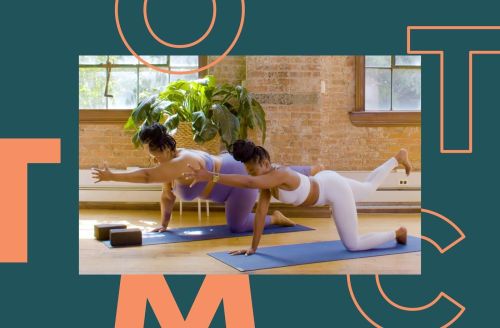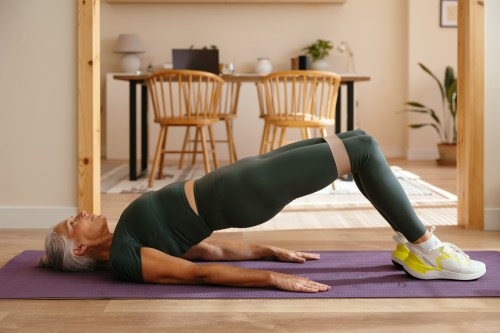This Twisting Yoga Flow Wrings Out Your Body and Gets You Unstuck Like None Other
Elevate your practice with twisting yoga poses and explore their benefits for flexibility and stress relief.

If your body is feeling a bit stuck and stagnant, you’re not alone. If you work a sedentary job—which a majority of us do— you might simply not be getting as much natural movement as you’d like. But there are ways to wring out your body and get yourself unstuck from those feels, particularly with twisting yoga poses (aka any pose that rotates and stretches the muscles of your back).
Experts in This Article
certified yoga practitioner and creative wellness entrepreneur
wellness artist, yoga and creative mindfulness facilitator
In the Trainer of the Month Club video above, yoga teachers Paris Alexandra and Alicia Ferguson have dreamed up the twistiest yoga class you can imagine to help target the muscles of your spine through twisted lunges, chair poses, Warrior IIs, and more. (As an added bonus, you’ll even work on your stability with some balancing poses.)
All you’ll need for this yoga flow is a yoga block (or a water bottle you can lean on) and, of course, your trusty yoga mat. This class is going to leave you feeling sweaty and refreshed at once.
35 minutes of twisting yoga poses, coming right up
1. Balasana (child’s pose): Come onto your knees and push your hips back to come into child’s pose. Keep your knees together or spread them apart depending on where you want to feel the stretch and how ready your lower back feels for your practice. Stretch your arms forward and breathe.
2. Bitilasana Marjaryasana or Chakravakasana (cat-cow): Come to all fours with your shoulders over your wrists and your hip bones over your kneecaps. On an inhale, press your chest forward through your arms (this is cow pose); on your exhale, curl your spine and tuck your chin (this is cat pose). Move through different patterns with the spine: Draw circles with your hip bones, come into child’s pose, and move through your spine freely.
3. Dandayamana Bharmanasana (balancing tabletop pose): Come to all fours with your hips directly over your knees and your wrists above your ankles. Extend your right leg straight back and your left arms straight forward without allowing your back to arch. Brace your core and tap your right toes to the outside of your left foot. Return to center, then cactus your right leg and left arm at the same time to form a “hydrant” shape of sorts. Complete this move three times on both legs.
4. Adho Mukha Svanasana (downward dog): Press into your hands and lift your hips back into downward-facing dog. Bend your knees slightly and think of angling your sitz bones to the sky. Take deep breaths here, bending one knee and straightening the other to work into the calves and thighs.
5. Bhujangasana (cobra pose): Come forward to plank and lower onto your belly. Bring your fingertips alongside your ribs. Use the strength of your back muscles to lift your chest off the ground, looking forward at the ground so you don’t strain your neck. Return to downward dog.
6. Eka Pada Adho Mukha Svanasana (three-legged downward dog): Extend your right leg straight back without opening your hip.
7. Anjaneyasana (low lunge): Step your right foot in between your hands, place your left knee gently on the floor, and reach your arms up to the sky. Bring your hands to the floor and step back into down dog. Repeat steps 12 and 13 on your left side.
8. Parivrtta Anjaneyasana (revolved lunge): Bring your hands to heart’s center and twist toward the right, hooking your left elbow on your right thigh. Engage your belly to revolve your chest in the direction of the sky.
9. Parsvottanasana (pyramid pose): Return to low lunge and straighten your right leg. Fold forward as much as you can without curling your chest. Place blocks under the hands to bring the floor up to you.
10. Virabhadrasana III (warrior III): After moving through one more downward dog and through low lunge on your right leg, start to rock back and forth until you engage your body to come forward on your right leg. Your left leg, torso, and arms will turn your body into a T-shape. Balance here, stretching through your arms to feel your core light up.
11. Parivrtta Anjaneyasana (revolved lunge) with the arms open: Gently land your left foot back on earth and come into a high lunge. Twist toward the right so that your left fingertips branch out over your right knee and your right fingertips stretch to the back of your mat. This is a twisty one, so breathe, breathe, breathe. If you feel comfortable, place your right hand on the back of your left thigh and stretch your left fingertips overhead.
12. Virabhadrasana II (warrior II): Return to center and spin your left foot down so that it’s parallel to your right arch. Bring your arms up so that they’re in that T-shape you know and love. Bend more deeply into your knee and tuck your pelvis under. From here, place your left hand on your left thigh and reach your right fingertips over your right ear. Return to down dog.
Repeat steps six through 12 on the opposite leg.
13. Uttanasana (forward fold): From downward dog, bend your knees as much as you need to and walk forward to the front of your mat. Release the tension from your neck and jaw and swing your arms back and forth, back and forth. Relax here. Interlace your elbows if you like and just let everything hang.
14. Tadasana (mountain pose): Without locking your knees, slowly roll all the way up to standing.
15. Utkatasana (chair pose): Bend your knees, push that booty back, and swoop your arms up so they’re tracking right alongside your ears. Feel the burn here and keep your spine as neutral as possible.
16. Parivrtta Utkatasana (twisted chair pose): Bring your hands to heart center and twist toward the right once more, hooking your left elbow over your right quad. Come onto the ball of your left foot and slowly, carefully, stretch the left leg back and place your toes on the floor so you’re in a twisted low lunge.
Come into downward dog, then repeat moves 13 through 16 on the opposite side.
17.Malasana (garland pose): From tadasana, point your toes out and slowly sit down toward the ground so that the back of your thighs press up against the back of your calves. If you can, keep the entirety of each foot planted on the ground. You can slide a block right under your sitz bones, if that works better for your body.
18. Parivrtta Malasana (twisted garland pose): From your malasana, place your right fingertips on the ground next to the inner arch of your right foot and stretch your left fingertips to the sky. Breathe as you twist your chest open. Return to center and complete on the left, too.
19. Dandasana (staff pose): Sit back into staff pose with your legs straight out in front of you and your back as strong as possible.
20. Paschimottanasana (forward fold): Fold over your legs, gently, bending your knees as much as you need to rest the chest against the quads.
21. Supta Matsyendrasana (reclined twist): Lie on your back and either eagle wrap your right leg over your right or bring your right ankle over your left knee. Drop your legs over to the left and stretch your right fingers to the right. See if you can plant both shoulder blades onto the floor. Come back to center and twist to the opposite side.
22. Savasana (corpse pose): Stretch out your legs and arms, tuck your tailbone under, and relax your shoulders. Rest! You did it.
The benefits of twisting poses
According to Ekhart Yoga, there are quite a few reasons you may want to give twisting yoga asanas a go:
- 1.They strengthen your core, working your abs (stomach muscles), obliques (side torso muscles), and back.
- 2.They help with spinal mobility, improving your spine’s range of motion so you can do everyday movements (like reach over to grab something) easily and without pain.
- 3.They help with digestion, creating movement in and around your organs to help food be moved along.
- 4.They lift your energy and decompress your spine safely.
Safety tips to know when doing twisting yoga poses
There are a few precautions to keep in mind when doing twisting poses, according to Himalayan Yoga Academy:
- 1.Remember to breathe.
- 2.Ground your shoulders and lengthen your spine.
- 3.Don’t twist from your lower back—you want to keep your foundation stable. Focus on twisting from your middle and upper back.
- 4.Your twists shouldn’t feel painful. If they do, scale back the twist or exit the pose immediately.
FAQ
1. Who should not twist in yoga?
While everyone should get the go-ahead from their doc before adding new poses—like twists—into their yoga routine, people who are pregnant or have chronic digestive issues, joint problems, or spinal disc injuries may want to avoid twisting yoga poses altogether, according to Himalayan Yoga Academy.
If you do attempt twisting yoga poses in your practice and feel pain, exit the pose immediately and chat with your healthcare provider.
2. How often should you do yoga twists?
If you want to add twisting yoga poses to your practice to improve flexibility and strength, it’s best to do so three to five times a week, Kajuan Douglas, a yoga teacher in New York City, previously told Well+Good. This is because you want to allow your body enough time to rest and recover.










